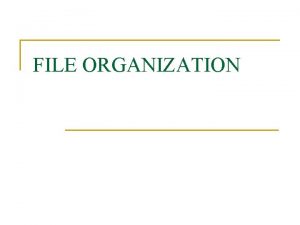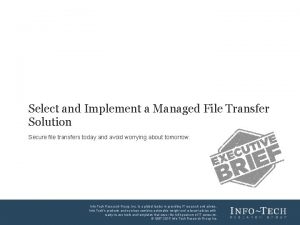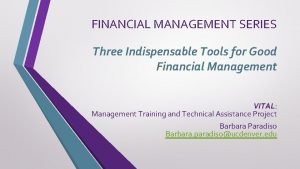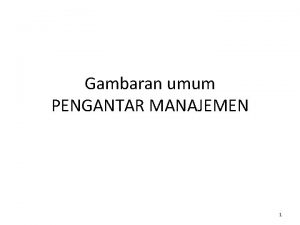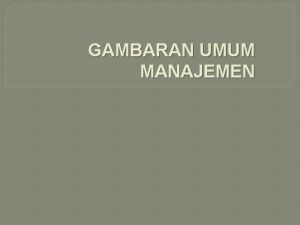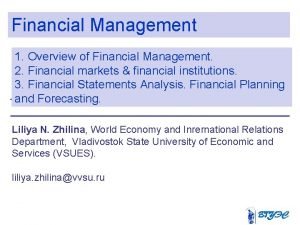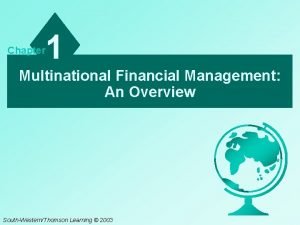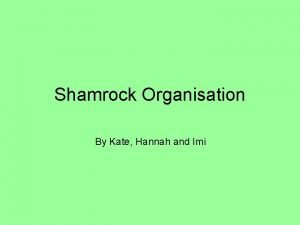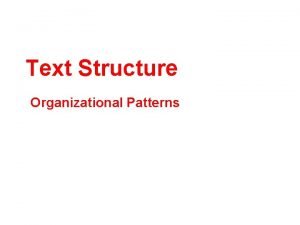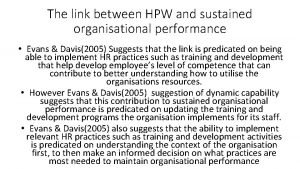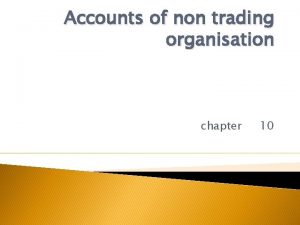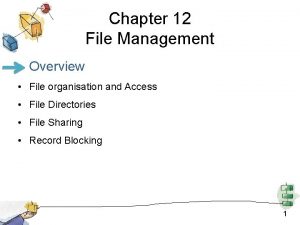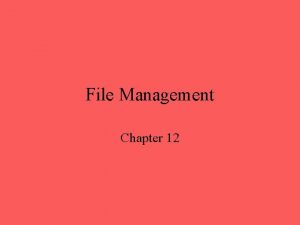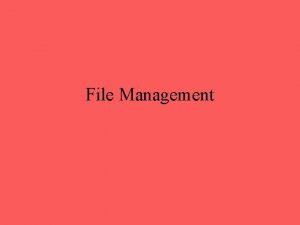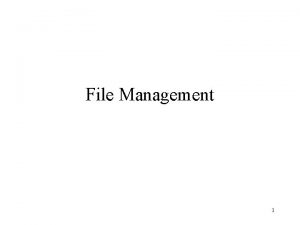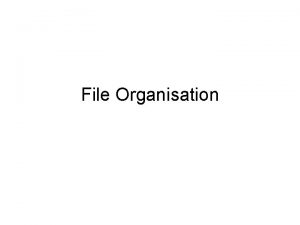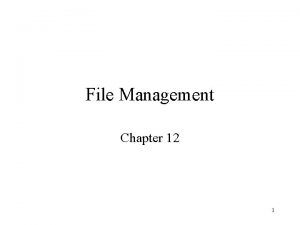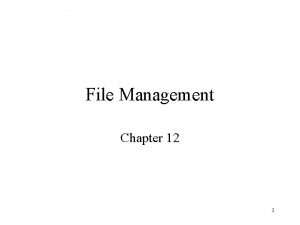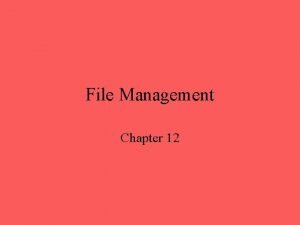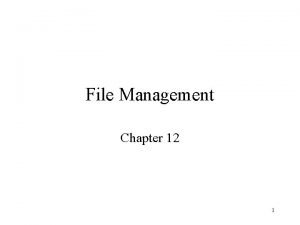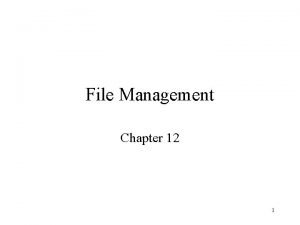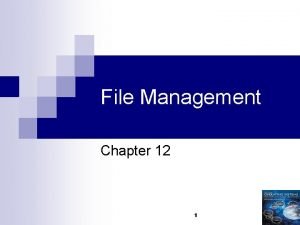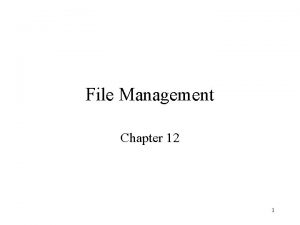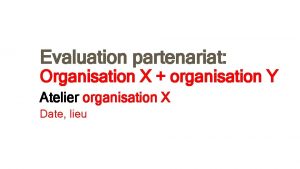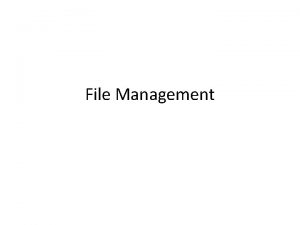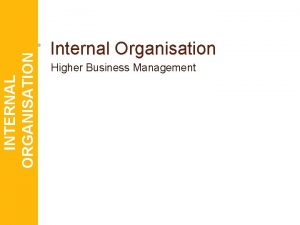Chapter 12 File Management Overview File organisation and










































- Slides: 42

Chapter 12 File Management • Overview • File organisation and Access • File Directories • File Sharing • Record Blocking 1

Files • Files are the central element to most applications – file as an input to applications – file as an output for long-term storage and for later access • Desirable properties of files: – Long-term existence – Controlled sharing between processes – Structure that is convenient for particular applications 2

File Structure Fields and Records • Fields – Basic element of data • e. g. , student’s last name – Contains a single value – Characterized by its length and data type • Records – Collection of related fields • e. g. , a student record – Treated as a unit 3

File Structure File and Database • File – Collection of similar records – Treated as a single entity and may be referenced by name – Access control restrictions usually apply at the file level • Database – Collection of related data – Explicit relationships exist among elements – Consists of one or more files 4

A Big Picture How to organize records in a file and access a particular record in a file? How to organize records as a sequence of blocks for I/O? individual block I/O requests must be scheduled for optimizing performance How to identify and locate a selected file? How to enforce user access control in shared systems? 5

Roadmap • Overview • File organisation and Access • File Directories • File Sharing • Record Blocking 6

File Organization • The basic operations that a user or application may perform on a file are performed at the record level – The file is viewed as having some structure that organizes the records • File organization refers to the logical structuring of records – Determined by the way in which files are accessed (access method) 7

Criteria for File Organization • Important criteria include: – Short access time – Ease of update – Economy of storage – Simple maintenance – Reliability 8

Criteria for File Organization • Priority will differ depending on the use – For batch mode file processing, rapid access for retrieval of a single record is of minimal concern • These criteria may conflict – Use of indexes (conflict with economy of storage) can be a primary means of increasing the speed of access to data 9

The Pile • Data are collected in the order they arrive – No structure • Purpose is to accumulate a mass of data and save it • Records may have different fields – field should be self-describing (field name + value) – field length should be known (delimiters, subfield or default for a field type) 10

The Pile • Record access is by exhaustive search • Used when data are collected and stored prior to processing or data are not easy to organize • Uses space well when data vary in size and structure • Adequate for exhaustive searches • Easy to update • Unsuitable for most applications 11

The Sequential File • Fixed format used for records • Records are of the same length – same number of fixed-length fields in a particular order • Only the values of fields need to be stored • Field name and length are attributes of the file structure 12

The Sequential File • Key field – Uniquely identifies the record – Records are stored in key sequence • Optimal for batch applications if they involve the processing of all the records • Easily stored on tape and disk • Poor performance for interactive applications – considerable processing and delay due to the sequential search of the file for a key match 13

Indexed Sequential File • An index is added to support random access – An index record contains a key field and a pointer into the main file – The index is a sequential file – For searching • Search the index to find the highest key value that is equal to or precedes the desired key value • Search continues in the main file at the location indicated by the pointer 14

Indexed Sequential File Example • Consider searching a particular key value in a sequential file with 1 million records – without index • requires on average one-half million record accesses – with an index containing 1000 entries with the keys in the index evenly distributed over the main file • requires on average 500 accesses to the index file + 500 accesses to the main file 15

Indexed Sequential File • An overflow file is added • A new record is added to the overflow file and is located by following a pointer from its predecessor record • The indexed sequential file is occasionally merged with the overflow file in batch mode • Greatly reduces the time required to access a single record, without sacrificing the sequential nature. 16

Indexed File • Records are accessed only through their indexes – no restriction on the placement of records – allows variable-length records • Uses multiple indexes for different key fields – An exhaustive index contains one entry for every record in the main file – A partial index contains entries to records where the field of interest exists 17

Indexed File • When a new record is added to the main file, all of the index files must be updated. • Used mostly in applications where – timeliness of information is critical and – data are rarely processed exhaustively – examples: airline reservation systems and inventory control systems 18

Roadmap • Overview • File organisation and Access • File Directories • File Sharing • Record Blocking 19

File Directory • Contains information about files – Attributes – Location – Ownership • Directory itself is a file owned by the operating system 20

Directory Elements • Basic Information – File name: must be unique – File type: e. g. , text, binary – File organization • Address Information – Volume: device on which file is stored – Starting address: e. g. , cylinder, track on disk – Size used: in bytes, words or blocks – Size allocated: maximum size of the file 21

Directory Elements • Access Control Information – Owner: able to grant/deny access to other users and to change these privileges – Access information: e. g. , user’s name and password for each authorized user – Permitted actions: controls reading, writing, executing, transmitting over a network • Usage Information – Date Created, Identity of Creator, Date Last Read Access, Identity of Last Reader, Date Last Modified 22

Hierarchical, or Tree-Structured Directory • Master directory with user directories underneath it • Each user directory may have subdirectories and files as entries • Each directory and subdirectory can be organized as a sequential file 23

Hierarchical, or Tree-Structured Directory • Easily enforce access restriction on directories. • Easily organize collections of files. • Minimize the difficulty in assigning unique names. 24

Naming • The tree structure allows users to find a file by following a path from the root or master directory down various branches until the file is reached • The series of directory names, culminating in the file name itself, constitutes a pathname for the file • Duplicate filenames are possible if they have different pathnames 25

Naming • Usually an interactive user or a process is associated with a current or working directory – Files are referenced relative to the working directory unless an explicit full pathname is used 26

Roadmap • Overview • File organisation and Access • File Directories • File Sharing • Record Blocking 27

File Sharing • In multiuser system, there is almost always a requirement for allowing files to be shared among a number of users • Two issues – Access rights – Management of simultaneous access 28

Access Rights • A wide variety of access rights have been used by various systems – often as a hierarchy, with each right implying those that precede it. • None – User may not know the existence of file by not allowing to read the user directory that includes this file • Knowledge – User can only determine that the file exists and who its owner is 29

Access Rights cont… • Execution – The user can load and execute a program but cannot copy it, e. g. , proprietary programs • Reading – The user can read the file for any purpose, including copying and execution • Appending – The user can add data to the file but cannot modify or delete any of the file’s contents 30

Access Rights cont… • Updating – The user can modify, delete, and add to the file’s data. • Changing protection – User can change access rights granted to other users • Deletion – User can delete the file 31

User Classes • Access can be provided to different classes of users – Owner: usually the files creator, has full rights and may grant rights to others – Specific users: individual users who are designated by user ID – User groups: a set of users identified as a group – All: all users who have access to this system 32

Simultaneous Access • When access is granted to append or update a file to more than one user, the OS or file management system must enforce discipline • User may lock the entire file or individual records during update • Mutual exclusion and deadlock are issues for shared access, ref. readers/writers problem 33

Roadmap • Overview • File organisation and Access • File Directories • File Sharing • Record Blocking 34

Blocks and records • Records are the logical unit of access of a structured file • Blocks are the unit for I/O with secondary storage • For I/O to be performed, records must be organized as blocks. • Three methods of blocking are common – Fixed length blocking – Variable length spanned blocking – Variable-length unspanned blocking 35

Fixed Blocking • Fixed-length records are used, and an integral number of records are stored in a block • Unused space at the end of a block is internal fragmentation • Common for sequential files with fixedlength records 36

Fixed Blocking 37

Variable Length Spanned Blocking • Variable-length records are used and are packed into blocks with no unused space • Some records may span multiple blocks – Continuation is indicated by a pointer to the successor block • Efficient for storage and does not limit the size of records 38

Variable Blocking: Spanned • Difficult to implement • Records that span two blocks require two I/O operations 39

Variable-length unspanned blocking • Uses variable length records without spanning • Wasted space in most blocks because of the inability to use the remainder of a block if the next record is larger than the remaining unused space • Limits record size to the size of a block 40

Variable Blocking: Unspanned 41

Revisit the Big Picture User views the file as having some structure that organizes the records; different access methods reflect different file structures Describes the location of all files plus their attributes Records must be organized as a sequence of blocks for output and unblocked after input individual block I/O requests must be scheduled for optimizing performance Only authorized users are allowed to access particular files in particular ways 42
 File-file yang dibuat oleh user pada jenis file di linux
File-file yang dibuat oleh user pada jenis file di linux Indexed sequential organization
Indexed sequential organization Chapter 1 an overview of financial management
Chapter 1 an overview of financial management Market overview managed file transfer solutions
Market overview managed file transfer solutions Elements and their properties section 1 metals
Elements and their properties section 1 metals Financial management is indispensable in any organisation
Financial management is indispensable in any organisation Difference between logical file and physical file
Difference between logical file and physical file Content management system overview
Content management system overview Introduction to hrm
Introduction to hrm Project management topics
Project management topics Use case diagram for gym management system
Use case diagram for gym management system What is real-time interaction management
What is real-time interaction management Management overview
Management overview Management overview
Management overview Overview of financial management
Overview of financial management Centralized multinational financial management
Centralized multinational financial management An overview of financial management
An overview of financial management Chapter 24 trauma overview
Chapter 24 trauma overview Emt chapter 14 medical overview
Emt chapter 14 medical overview Chapter 9 lesson 2 photosynthesis an overview
Chapter 9 lesson 2 photosynthesis an overview Chapter 12 selling overview
Chapter 12 selling overview Chapter 2 an overview of the financial system
Chapter 2 an overview of the financial system Chapter 1 overview of verb tenses
Chapter 1 overview of verb tenses Overview of personal finance chapter 1
Overview of personal finance chapter 1 Tooth numbering system in usa
Tooth numbering system in usa Foundations in personal finance answers chapter 1
Foundations in personal finance answers chapter 1 Chapter 32 an overview of animal diversity
Chapter 32 an overview of animal diversity Chapter 1 overview of financial statement analysis
Chapter 1 overview of financial statement analysis Fungsi sistem file
Fungsi sistem file Distributed file system definition
Distributed file system definition What does a markup tag tells the web browser
What does a markup tag tells the web browser In a file-oriented information system, a transaction file
In a file-oriented information system, a transaction file Shamrock organization
Shamrock organization Diff between computer architecture and organization
Diff between computer architecture and organization Flow chart for interrupt cycle
Flow chart for interrupt cycle Text structure and organisation
Text structure and organisation Computer organisation and architecture
Computer organisation and architecture How hpw contributes to employee engagement
How hpw contributes to employee engagement Trading and non trading organisation
Trading and non trading organisation Module 4 operating systems and file management
Module 4 operating systems and file management Overview of transcription and translation
Overview of transcription and translation Data cleaning problems and current approaches
Data cleaning problems and current approaches The two rows of elements that seem to be disconnected
The two rows of elements that seem to be disconnected

